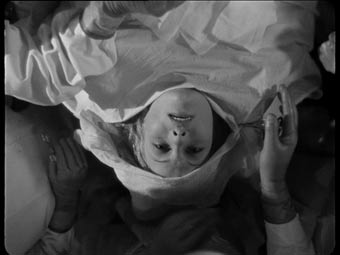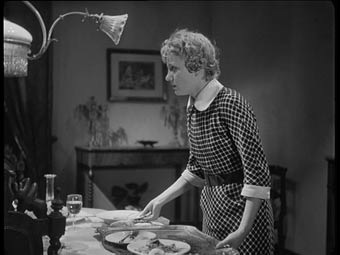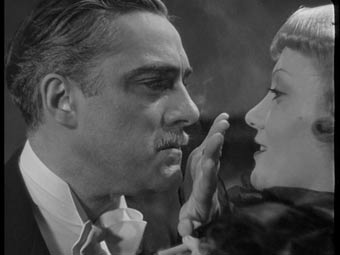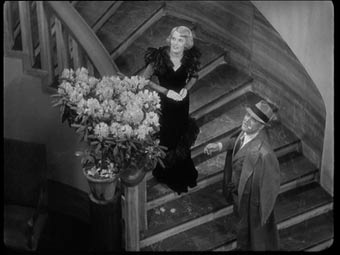| |
'The camera exists to create new art – to show what can't be seen elsewhere, neither in theatre nor in life.' |
| |
Max Ophuls |
| |
'My cinematographer, Ubaldo Arata, reminded me of Mercutio from Romeo and Juliet. He had the same physique, the same love for the bottle. That said, he also had the eye of Titian, and the audacity of Michelangelo. In the space of a few seconds, he would swing the camera around in a complete circle, at the risk of filming the crew along with the actors: "Doesn't matter," he would say, in response to my anxious protests. "This way, at least people will know it's a film!"' |
| |
Max Ophuls on the photographic style of La Signora di tutti |
It wasn't so long ago that rape victims were accused of being somehow complicit in their assault because of the way they dressed or behaved. The inference was that the scumbags who attacked them had only stooped to rape because they'd been led on by women whose past sexual histories were exaggerated and paraded in open court as evidence of their loose morals and unworthiness of jury sympathy. And the more socially 'respectable' the attacker, the more willing the gullible of both genders were to take his side. Oh, what a wonderful world. It's an attitude to women that was tackled head on by writer Tom Topor and director Jonathan Kaplan in their 1988 The Accused, but was also, in its way, a theme central to Max Ophuls' 1934 breakthrough feature La signora di tutti [Everybody's Lady]. We may be talking infatuation rather than rape – but then look when it was made – but the finger of blame is repeatedly pointed at a young girl that men (and even women) fall for at the cost of their families, careers and even lives.
The film begins with theatrical agent Veraldi (Franco Coop), a wiry and self-confident dealer with a half Chelsea smile, arguing a movie deal for rising star Gaby Driot (aka Gabriella Murge before the poster girl name change, played by Isa Miranda) with the unnamed head of a large French production company (Mario Ferrari). The deal is struck, but come the first day of shooting there's no sign of the lead player. Veraldi is sent to retrieve her from her hotel and finds her unconscious on the bathroom floor, critically injured from a suicide attempt. She is rushed to hospital and prepared for a life-or-death operation, and as the anaesthetic takes hold she recalls her past life and the events that brought her to this pivotal moment.

Such a brief but hopefully concise summary cannot hope to capture the runaway energy of these opening scenes. Starting with a spiral wipe on a spinning record from which Gaby's voice emanates singing the title song, we're plunged into the midst of a breathless debate in which Veraldi haggles prices and movie deal specifics. We then leap-frog to the first day of the film shoot as a production assistant rockets through the studio in a search for the missing star, his every move followed by a camera that tracks and pans with him like an obsessive stalker on a cardio programme. Even the preparations for Gaby's surgical procedure are strikingly realised, the anaesthetic delivered via a helmet that descends from up high like a torture device owned by Ming the Merciless.
This dispensing with preamble continues in Gabriella's narcotic-induced drift back to her schooldays, where the news that a tragedy has befallen teacher Professor Sommi prompts her to faint on the spot. We soon find out why. Family man Sommi had become infatuated with Gabriella, and unable to live without her has taken his own life. And who does the furious headmaster blame? You've got it. Expelled from school, she then incurs the wrath of her judgemental father (Lamberto Picasso), an ex-military man and widower whose over-protective attitude to his daughter is a likely contributor to her naivety about the opposite sex.
The moment of confrontation between father and daughter, or the tense build-up to it, vividly personalises the experience by focussing exclusively on the terrified Gabriella as she clears the dinner table, awaiting the moment she'll have to answer for what happened, while her father and sister Anna (Nelly Corradi) argue furiously in the next room. I remember the first time I saw Lindsay Anderson's If.... and marvelling the director's decision to stay with Mick Travis as he waited his turn to be caned by his peers, and at how closely this bonded us with the emotion of the experience by making it subjective, forcing us to share his trepidation at what was to come. A couple of years later I first saw Spartacus and realised that Stanley Kubrick had staged the exact same scene eight years earlier to even more stomach-churning effect, as Kirk Douglas and Woody Strode sit waiting their turn to fight to the death, while the battle that precedes theirs can be heard unfolding but unseen by us in the auditorium outside. The stakes may not be quite as high in La signora di tutti, but in this sequence Ophuls pre-dates even Kubrick by twenty-four years.

He then delivers one of the film's many structural surprises by bypassing the confrontation and hopping forward to a point when Gabriella's punishment has been in place for some time, long enough for her and Anna to successfully persuade their father to allow them to attend a party being thrown by Roberto Nanni (Federico Benfer), the son of the local gentry and the second man to become captivated by Gabriella's beauty. At the party itself, Roberto dances with Gabriella and is soon declaring his determination to see her again, whatever his disapproving mother Alma (Tatiana Pawlova) might say. Except Alma proves notably less judgemental than expected and is touched by Gabriella's honesty and kindness, and with Roberto in Rome and her husband away on business, she asks Gabriella to visit her regularly. The two soon become close, their relationship developing into one of mutual emotional dependency, with Alma filling the hole left by the loss of Gabriella's mother, and Gabriella providing the companionship the weak-bodied Alma craves in her own family's absence. This harmony is dented and eventually shattered by the return of Alma's husband Leonardo (Memo Benassi), who is bewitched from the moment he lays eyes on this newcomer and is soon spending far more time at the family home. Then one night, a combination of Leonardo's infatuation, Alma's dependency and Gabriella's longing for emotional contact lead to tragedy...
Any film that opens with a suicide attempt is unlikely to end happily, and if you're looking for an upbeat date movie to warm a winter's evening then you've come to the wrong place. This is a downbeat story in which Gabriella becomes the unwilling catalyst for the blind self-destruction of others, which leads to her being misunderstood by those who judge her, including some of the film's more ardent fans. On this very disc, Tag Gallagher suggests that she is actually a witch, someone who unwittingly infects the lives of almost everyone she meets, but this strikes me very much as a male-centric reading and one that would not be out of place in the film itself. That she does not resist the attentions directed at her is taken as evidence of complicity rather than her longing for relationships she has never known and will ultimately never have. In Alma she finds the mother she has long since lost, and in Leonardo the emotional bond her authoritative father is unwilling to provide, a relationship foreshadowed by the early attentions of Professor Sommi. Her father angrily says to Anna at one point, "She doesn't know how dangerous she is," but the understanding that Gabriella really lacks is the danger represented by others, and the potential consequences of her own emotional vulnerability.

What makes the film so compelling and intermittently invigorating has less to do with the story than the manner in which it is told. There's not a shot nor a sequence here that hasn't been planned to perfection, a technical tour-de-force in which even the most complex camera moves and eye-catching edits are employed primarily to develop the the story and characters. By all means watch the film for the invention and energy of its filmmaking, as not a scene goes by that isn't littered with with technical handling that is worthy of academic study, but to do so in isolation would fail to acknowledge Ophuls' determination to tell Gabriella's story in genuinely cinematic terms. So innovative and confident is the filmmaking here that it's genuinely hard to believe this was made just seven years after The Jazz Singer first introduced the public to the concept of synchronised sound. There is always clear purpose to the sometimes thrilling mobility of cinematographer Ulbaldo Arata's camera. As it glides through the film studio, recording the search for the missing actress, it neatly illustrates the sheer scale of the production in which she is starring, and when Gabriella and Roberto dance, the camera moves with them, capturing the emotion of the moment in a manner that would be reproduced and adapted in countless films to come. When it sweeps emotively around Leonardo to reveal the approaching Gabriella when the couple first meet, a bond is instantly formed, one later developed by a long track up to the couple in intimate close-up, and the twinned dolly shots following Leonardo's car as it shadows Gabriella's boat that is cut with their conversation. And that, believe me, is just a sprinkling.
It's this sometimes exuberant execution, coupled with a string of fine performances and some savvy support role casting, that makes this downbeat melodrama such consistently captivating viewing. Our engagement with Gabriella is one that prompts sadness and empathy with her and her fate, right up to the perfectly judged finality of the ending. The journey there allows for commentary on the potentially obsessive and damaging nature of desire, and includes a few stabs at the vacuity of the star system ("An actress must be as the public wants her," Veraldi tells Gaby, "full of sunshine and youth"). But it's Gabriella herself who nails the film's most poignant theme when she remarks of the social isolation into which she and Leonardo have been plunged, "We are very much alone, very alone."
There are no specific details of the transfer in the accompanying booklet, but the press release spoke of "a beautiful new transfer from pristine film materials in its original 1.37:1 aspect ratio," and it's not far wrong. For a film made in Europe in 1934, La signora di tutti is in fabulous shape, boasting a lovely level of detail, punchy contrast, visible but never distracting film grain and little sign of damage or dirt. There is some very mild flickering in darker scenes (and a couple of the daylight exteriors) and there's the suspicion that a small amount of picture detail may have been lost to get those black levels looking so firm, but for the most part this is well up to the expected MoC standard. The framing is indeed in the original 1.37:1 and is slightly pillarboxed even on 4:3 screens (see grabs), with the curve of the film frame edges visible in order to show the maximum picture information.

The Dolby 2.0 mono soundtrack may have the expected range restrictions typical of films of the period, but is otherwise pleasingly free of obvious damage and even background hiss or fluff.
So Alone (29:35)
Film writer Tag Gallagher takes us on a whistle-stop tour of Ophuls' early life and career, then homes in on La signora di tutti, which he analyses with the attention to detail of a university film studies lecture. Much of it is intriguing and there's some lovely background on the production – Ophuls apparently pricked actress Isa Miranda with pins to provoke the right emotional response, and despite being one of the few Italian films shot with direct sound, Miranda's voice was dubbed by fellow actress Nelly Corradi. That said, I can't help wondering if Gallagher's claim that cigars and cigarettes smoked by the male characters are phallic power statements isn't reading more into the film than was originally intended.
Booklet
Another fine MoC booklet that compliments the film well. Contained within is an essay on the film by Luc Moullet, a Testimonial by lead actress Isa Miranda that provides an intriguing peek into Ophuls' working methods, a Dossier on the film with contributions from Ophuls, Isa Miranda and filmmaker Alfredo Guarini, credits and film stills.
La Ronde aside, I'll confess to being less well versed in the cinema of Max Ophuls than I by all rights should be, so was perhaps even more astonished than the director's fan base by the sheer virtuosity of La signora di tutti, a melancholic but beautifully told story whose every scene bristles with small cinematic thrills. A lovely transfer, an informative documentary and a fine booklet make this something of a must-have. Warmly recommended.
|